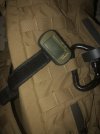Haven't you all heard....there are mini polarized places popping up and true north an south have changed positions...not entirely....but soon....
Was at Mt Hood hunting....walked less than .25 from truck....pushed button to reverse course...gps said go this way.....exactly....the wrong way.....would have been a hell of a hike going that way in the dark.......
Was at Mt Hood hunting....walked less than .25 from truck....pushed button to reverse course...gps said go this way.....exactly....the wrong way.....would have been a hell of a hike going that way in the dark.......

